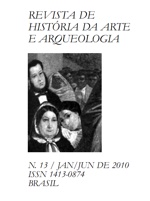Abstract
In the first decade of the Republic, the official artistic teaching in Rio de Janeiro, centered on the National School of Fine Arts (NSFA), has shown a singular openness towards the aesthetic diversity of European art. In this sense, and transcending
the traditional links with countries like Italy and France, some Brazilian artists, funded by the NSFA, or by their own expenses, spent study seasons in the city of Munich, one of the most dynamic artistic centers of the end of the nineteenth century. The present article seeks to discuss the reasons behind the coming of the Brazilian artists to Munich, as well as the marks that the artistic experiences in that city have left to their works.
References
“A Nossa Coleção de Pinturas”. Gazeta de Notícias. Rio de Janeiro, 24 mar. 1891.
ATAS das sessões do Conselho Escolar da Escola Nacional de Belas Artes, 1891-1901. Acervo Arquivístico do Museu Dom João VI, EBA/UFRJ.
AULER, Guilherme. “Presença de alguns artistas germânicos no Brasil”. In: Arquivos da Escola Nacional de Belas Artes. Rio de Janeiro, Ano X, 1964.
BARATA, Mário. “Textos antigos sobre H. Seelinger e H. Cavalleiro.” In: Arquivos da ENBA. Rio de Janeiro: UFRJ / ENBA, Ano VIII, 1962.
CAMARGO, Geraldo L. V. de. Paranismo: Arte, ideologia e relações sociais no Paraná. 1853-1953. (Tese de doutorado) Programa Pós-Graduação em História, Setor de Ciências Humanas, Letras e Artes da Universidade Federal do Paraná, (Prof. Dr. Luiz Geraldo Santos Silva), Curitiba, 2007.
COLI, Jorge. Vitor Meirelles e a pintura internacional. (Tese de livre-docência) UNICAMP, Campinas, 1997.
COSTA, Angyone. A inquietação das abelhas (O que dizem nossos pintores, escultores, arquitetos e gravadores, sobre as artes plásticas no Brasil). Rio de Janeiro: Pimenta de Mello & Cia, 1927.
CUNHA, Alexandre Eulálio Pimenta da (Supervisão). Nosso Século. Rio de Janeiro: Abril Cultural, Vol. 1, 1985.
DAZZI, Camila. As relações Brasil-Itália na arte do último oitocentos: estudo aprofundado sobre Henrique Bernardelli (1880-1890). (Dissertação de mestrado) Programa de Pós-graduação em História IFCH/UNICAMP, (Prof. Dr. Luciano Migliaccio), Campinas, 2006.
DAZZI, Camila. “Meirelles, Zeferino, Bernardelli e outros mais: a trajetória dos pensionistas da Academia Imperial em Roma.” In: Revista de História da Arte e Arqueologia. Campinas, no 10, jul-dez. 2008.
“Deutsch-Römer”: Il mito dell’Italia negli artisti tedeschi, 1850-1900. Milano: Arnaldo Mandadori Editore/ De Luca Edizioni d’Arte, 1988.
DUQUE, Gonzaga. A Arte Brasileira; introdução e notas de Tadeu Chiarelli. Campinas, SP: Mercado das Letras, 1995 (1 ed. 1888).
EKSTEIN, Michael G.. “Biedermeier. Munich”. The Burlington Magazine, Vol. 129, no 1011, Jun. 1987.
FLECKNER, Uwe. “L’art alemmand et son public français. Recéption et transferts artistiques au XIXe siècle”. In: FLECKNER, Uwe; GAEHTGENS, Thomas W. (Org.). De Grünewald à Menzel: l’image de l’art allemand en France au XIXe siècle. Editions MSH, 2003.
FRANCISCO, Nagib. João Batista da Costa, 1865-1926. Rio de Janeiro: Edições Pinakotheke, 1984.
GINZBURG, Carlo. “Arte Italiana”. In: _____. Carlo. A micro-história e outros ensaios. Lisboa: Difel, 1991.
GUIDO, Ângelo. Pedro Weingärtner. Porto Alegre: Secretaria de Educação e Cultura, 1956.
“Helios Seelinger na Palavra de Seus Filhos.” Correio filatélico. Rio de Janeiro, no 18, ago. 1978.
HOFFMANN, Ernst Fedor. “Thomas Mann’s ‘Gladius Dei’”. In: PMLA. New York, Vol. 83, no 5, out. 1968.
LEITE, José R. T. “A ‘Belle Époque’”. In: Arte no Brasil. São Paulo: Abril Cultural, Vol. 2, 1979.
LEVY, Carlos R. M.. Karl Ernst Papf: 1833-1910. Rio de Janeiro: Pinakotheke, 1980.
LEVY, Carlos R. M. O Grupo Grimm: Paisagismo Brasileiro no século 19. Rio de Janeiro: Pinakotheke, 1980.
LIMA, Herman. História da Caricatura no Brasil. Rio de Janeiro: José Olympio Editora, 1963, Vol. 3.
LOBATO, Monteiro. “Pedro Américo”. Revista do Brasil. São Paulo, Ano I, no 11, nov. 1916.
MAKELA, Maria. The Munich Secession. Art and Artists in Turn-of-the-Century Munich. New Jersey: Princeton University Press, 1990.
MANN, Thomas. “Gladius Dei”. In: ____. Os famintos e outras histórias. Tradução de Lya Luft. – Rio de Janeiro: Nova Fronteira, 1982.
MARQUES, Luiz (Org.). 30 Mestres da Pintura no Brasil. SP/RJ: MASP/MNBA, 2001.
MATRIKELBÜCHER der Akademie der Bildenden Künste München, 1841- 1994.
MATTOS, Cláudia Valladão de (Org.). Goethe e Hackert: sobre a pintura de paisagem: quadros da natureza na Europa e no Brasil. São Paulo: Ateliê Editorial, 2008.
METZGER, Rainer (Texto). Munich 1900. La Sécession. Kandinsky et le Blaue Reiter. Éditions Hazan, 2009.
MENDGEN, Eva. Franz Von Stuck (1863-1928). “A Prince of Art”. Köln: Benedikt Taschen Verlag, 1995.
“Notas de Arte”. Jornal do Commercio. Rio de Janeiro, 9 set. 1903.
PEDERNEIRAS, Raul. “O irredentismo em arte”. Jornal do Brasil. Rio de Janeiro, 20 set. 1924.
PEIXOTO, Maria Elizabete Santos. Pintores alemães no Brasil durante o século 19. Rio de Janeiro: Edições Pinakotheke, 1989.
RELATÓRIO do ano de 1881, apresentado à Assembleia Geral Legislativa na 2ª sessão da 18ª Legislatura em 29 de maio de 1882. Disponível em: http://www.dezenovevinte.net/docu-mentos/relatorios_ministeriais/rltr_mntr_1881.htm. Acesso em: 1 jun. 2009.
RAUCH, Alexander. “Neoclasicism and the Romantic Movement. Painting in Europe between Two Revolutions 1789-1848.” In: TOMAN, Rolf (Ed.). Neoclassicism and Romanticism. Architecture. Sculpture. Painting. Drawings. 1750-1848. Ulmann & Könemann, 2007.
Rio de Janeiro, Vol. III, no 3, jul. 2008. Disponível em: http://www.dezenovevinte.net/19e20/19e20III3/. Acesso em: 1 jun. 2009.
SILVA, Maria do Carmo C. da. A obra Cristo e a mulher adúltera e a formação italiana do escultor Rodolfo Bernardelli. (Dissertação de mestrado) Campinas: Programa de Pós-graduação em História IFCH/UNICAMP, (Prof. Dr. Luciano Migliaccio), 2005.
TAYLOR, Joshua C. The fine arts in America. Chicago/London: The University of Chicago Press, 1979.
“Uma questão artística”. A Noite. Rio de Janeiro, 12 set. 1913.
VAISSE, Pierre. “Sur les rapports artistiques francoallemands au XIXe siècle”. Romantisme. Paris, Vol. 21, no 73, 1991.
VALLE, Arthur. “Repertórios Ornamentais e Identidades no Brasil da 1ª República”. In: Anais Eletrônicos do XIII Encontro ANPUH-Rio. Rio de Janeiro, 2008. Disponível em: http://www.encontro2008.rj.anpuh.org/resources/content/anais/1213300383_ARQUIVO_anpuh_2008.pdf. Acesso em: 1 jun. 2009.
WEISS, Peggy. Kandinsky in Munich. The Formative Jugendstil Years. Princeton, New Jersey: Princeton University Press, 1979.

This work is licensed under a Creative Commons Attribution 4.0 International License.
Copyright (c) 2021 Journal of Art History and Culture


